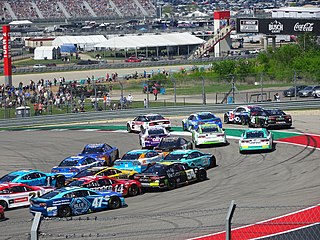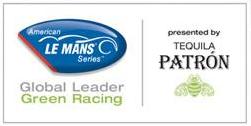
Auto racing is a motorsport involving the racing of automobiles for competition. In North America, the term is commonly used to describe all forms of automobile sport including non-racing disciplines.

Sports car racing is a form of motorsport road racing which utilises sports cars that have two seats and enclosed wheels. They may be either purpose-built sports prototypes which are the highest level in sports car racing or grand tourers based on road-going models and therefore, in general, not as fast as sports prototypes. Sports car racing is one of the main types of circuit auto racing, alongside open-wheel racing, touring car racing and stock car racing. Sports car races are often, though not always, endurance races that are run over particularly long distances or large amounts of time, resulting in a larger emphasis on the reliability and efficiency of the car and its drivers as opposed to outright car performance or driver skills. The FIA World Endurance Championship is an example of one of the best known sports car racing series.

The American Le Mans Series (ALMS) was a sports car racing series based in the United States and Canada. It consisted of a series of endurance and sprint races, and was created in the spirit of the 24 Hours of Le Mans.

Endurance racing is a form of motorsport racing which is meant to test the durability of equipment and endurance of participants. Teams of multiple drivers attempt to cover a large distance in a single event, with participants given a break with the ability to change during the race. Endurance races can be run either to cover a set distance in laps as quickly as possible, or to cover as much distance as possible over a preset amount of time.

The Porsche 961 was a racing car built by Porsche and based on their 959 sports car. It was intended for Group B sports car racing, complementing the purpose-built 956 and 962C which ran Group C in the World Sports-Prototype Championship. The 961 project was short-lived, running only three races and seeing the construction of only one car. Plans to sell the car to customers were scrapped when the Group B class was canceled.
The International Motor Sports Association (IMSA) is a North American sports car racing sanctioning body based in Daytona Beach, Florida, under the jurisdiction of the ACCUS arm of the FIA. It was started by John Bishop, a former executive director of SCCA, and his wife Peggy in 1969 with help from Bill France Sr. of NASCAR. Beginning in 2014, IMSA is the sanctioning body of the WeatherTech SportsCar Championship, the premier series resulting from the merger of Grand-Am Road Racing and the American Le Mans Series. IMSA is owned by NASCAR, as a division of the company.

The 24 Hours of Le Mans is an endurance-focused sports car race held annually near the town of Le Mans, France. It is widely considered to be one of the world's most prestigious races, and is one of the races—along with the Monaco Grand Prix and Indianapolis 500—that form the Triple Crown of Motorsport, and is also one of the races alongside the 24 Hours of Daytona and 12 Hours of Sebring that make up the informal Triple Crown of endurance racing. Run since 1923, it is the oldest active endurance racing event in the world.

A Le Mans Prototype (LMP) is a type of sports prototype race car used in various races and championships, including the 24 Hours of Le Mans, FIA World Endurance Championship, IMSA SportsCar Championship, European Le Mans Series, and Asian Le Mans Series. Le Mans Prototypes were created by the Automobile Club de l'Ouest (ACO). The technical requirements for an LMP include bodywork covering all mechanical elements of the car. As of 2023, there are two classes within Le Mans Prototypes, designated LMP2 and LMP3.

Group C was a category of sports car racing introduced by the FIA in 1982 and continuing until 1993, with Group A for touring cars and Group B for GTs.

The World Sportscar Championship was the world endurance racing series run for sports car racing, sanctioned by the Fédération Internationale de l'Automobile (FIA), from 1953 to 1992. The championship evolved from a small collection of the most important sportscar, endurance, and road racing events in Europe and North America with dozens of gentleman drivers at the grid to a professional racing series where the world's largest automakers spent millions of dollars per year.

A Daytona Prototype was a type of sports prototype racing car developed specifically for the Grand American Road Racing Association's Rolex Sports Car Series as their top class of car, which replaced their main prototype racing class, specifically Le Mans Prototypes (LMPs). The cars later competed in the merged series of the IMSA SportsCar Championship, from 2014 to 2016, before being phased out and replaced by the Daytona Prototype International class in 2017. They are named after the main series event, the Rolex 24 at Daytona.
Group 5 was an FIA motor racing classification which was applied to four distinct categories during the years 1966 to 1982. Initially Group 5 regulations defined a Special Touring Car category and from 1970 to 1971 the classification was applied to limited production Sports Cars restricted to 5 litre engine capacity. The Group 5 Sports Car category was redefined in 1972 to exclude the minimum production requirement and limit engine capacity to 3 litres. From 1976 to 1982 Group 5 was for Special Production Cars, a liberal silhouette formula based on homologated production vehicles.

The Rolex Sports Car Series was the premier series run by the Grand American Road Racing Association. It was a North American-based sports car series founded in 2000 under the name Grand American Road Racing Championship to replace the failed United States Road Racing Championship. Rolex took over as series sponsor in 2002.

Group 4 referred to regulations for sportscars and grand touring (GT) cars used in racing and rallying, as regulated by the FIA. The group was introduced in 1954 and was replaced by Group B for the 1982 season.

Porsche has been successful in many branches of motorsport of which most have been in long-distance races.

IMSA GT was a sports car racing series organized by International Motor Sports Association. Races took place primarily in the United States and occasionally in Canada.
Embassy Racing was a British auto racing team founded by Jonathan France in 2003. Initially created as a conjunction with Xero Competition in the British GT Championship, the team expanded to become an independent team and began to win races in British GT before the team took a sabbatical year in 2006. Upon their return to motorsport, Embassy moved to the international Le Mans Series, running in a Le Mans Prototype class, as well as entering the British Superbike Championship's junior leagues, the Supersport and Superstock Championships, running with the support of Triumph Motorcycles under the MAP Embassy Triumph banner.

The IMSA SportsCar Championship, currently known as the IMSA WeatherTech SportsCar Championship under sponsorship, is a sports car racing series based in the United States and Canada and organized by the International Motor Sports Association (IMSA). It is a result of a merger between two existing North American sports car racing series, the American Le Mans Series and Rolex Sports Car Series. At its inception, the name was United SportsCar Championship, which subsequently changed to IMSA SportsCar Championship in 2016. Rolex SA's Tudor brand was the championship's title sponsor in 2014 and 2015, and since 2016 WeatherTech has served as title sponsor.

Grand Touring Endurance, shortened to GTE, was a set of regulations maintained by the Automobile Club de l'Ouest (ACO) and IMSA for grand tourer racing cars used in the 24 Hours of Le Mans, 24 hours of Daytona GTLM, and its associated series. The class was formerly known as simply Group GT between 1999 and 2004, and later referred to as Group GT2 between 2005 and 2010. The GT2 name has since been revived for a different set of regulations.

A Le Mans Hypercar (LMH) is a type of sports prototype race car that competes alongside LMDh entries in the Hypercar class of the FIA World Endurance Championship. It will also compete in the Grand Touring Prototype (GTP) class of the IMSA SportsCar Championship from 2023.


















